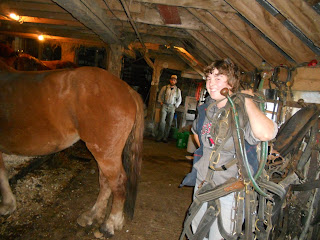Josh is a talented man. At the Farm School, he's our program director, but he's also a stonemason, a chef, a carpenter, a disciple of the Grateful Dead, and has about as much energy as a person could possibly have. This will be the ninth timber frame structure he's built. It'll be a classroom and living space that will attach to the end of our currently existing tool shed on the farm. Here's one of the plan drawings:
In our initial workshop, Josh handed us a glossary of terms, some of which I will now share with you, gentle reader:
Post and beam: A structural system whereby floor and roof loads are carried on principal timbers that may be merely stacked and fastened with hardware or may utilize timber joinery.
Joinery: The shaping of timbers where they mate to fasten or lock them.
Sills: Timbers that tie the bottom of the frame and distribute its weight along the foundation.
Tenon: The reduced end of a timber that fits into a mortise.
Mortise: The cavity that accepts the tenon.
Square rule: A system of layout in which a smaller, perfect timber is envisioned within a rough outer timber; all joints are cut to this inner timber. Many timbers in a Square Rule frame are interchangeable.
Rafters: The timbers spanning from eave to ridge to which the roof sheathing is attached.
Joist: The spanning timber that the floor is attached to.
Brace: A diagonal timber or a temporary piece of lumber that prevents distortion in a frame.
The wood is white pine from trees felled on the farm and milled down to size on the sawmill. The sills, posts and beams are very heavy eight by eight by sixteen inch pieces. With time, we'll also be milling the remaining pieces: floor and ceiling joists, rafters, braces, etc:
And into the greenhouse we go to set up our work area:
We will use no hardware. The joinery will all fit together like puzzle pieces. Here are the tools of the trade:
And finally, action!
I'm finding this work to be incredibly meditative. The tunes are going, it's warm in the greenhouse, and everyone is working in companionable silence. I feel a little bit like Michelangelo, holding my mallet and chisel and helping to create something that will eventually be a work of art. Okay, that's an exaggeration, but you get the idea. On the second day of work, the sun began to set and we were having a hard time seeing what we were doing. But nobody wanted to leave.
Tomorrow's another day.



























